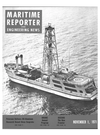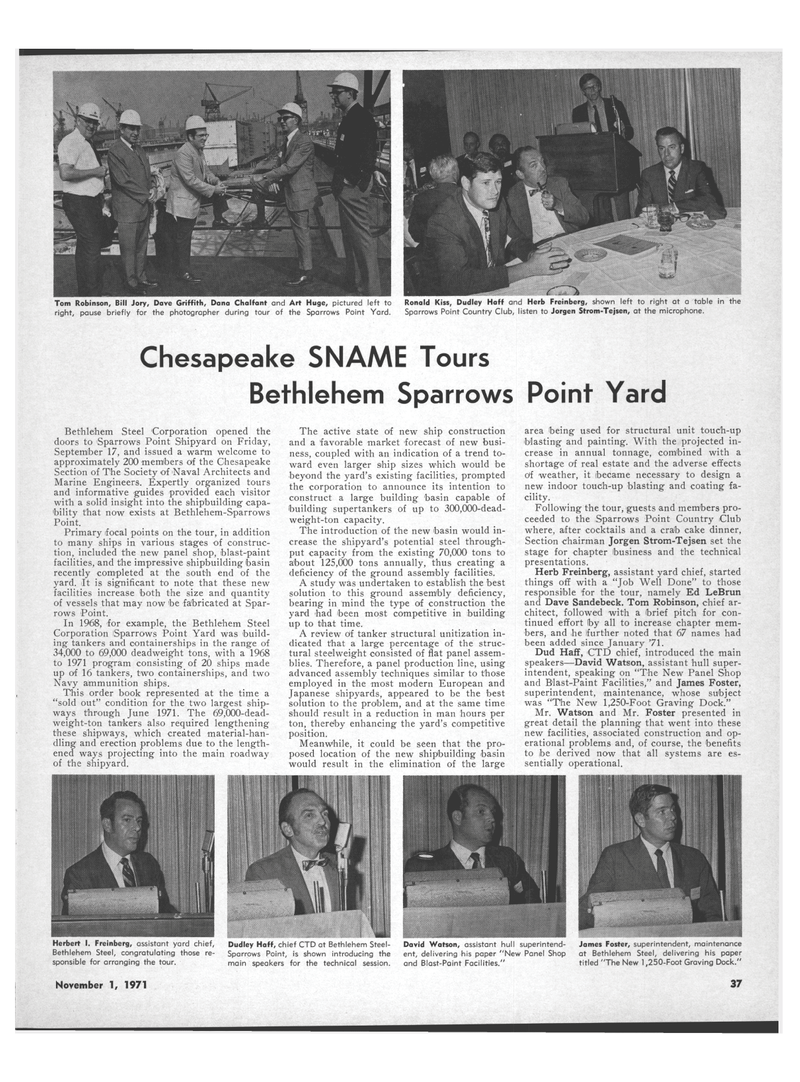
Page 35: of Maritime Reporter Magazine (November 1971)
Read this page in Pdf, Flash or Html5 edition of November 1971 Maritime Reporter Magazine
Chesapeake SNAME Tours
Bethlehem Sparrows Point Yard
Tom Robinson, Bill Jory, Dove Griffith, Dana Chalfant and Art Huge, pictured left to right, pause briefly for the photographer during tour of the Sparrows Point Yard.
Ronald Kiss, Dudley Haff and Herb Freinberg, shown left to right at a table in the
Sparrows Point Country Club, listen to Jorgen Strom-Tejsen, at the microphone.
Bethlehem Steel 'Corporation opened the doors to Sparrows Point Shipyard on Friday,
September 17, and issued a warm welcome to approximately 200 members of the Chesapeake
Section of The Society of Naval Architects and
Marine Engineers. Expertly organized tours and informative guides provided each visitor with a solid insight into the shipbuilding capa- bility that now exists at Bethlehem-Sparrows
Point.
Primary ifocal points on the tour, in addition to many ships in various stages of construc- tion, included the new panel shop, blast-paint facilities, and the impressive shipbuilding basin recently completed at the south end of the yard. It is significant to note that these new facilities increase both the size and quantity of vessels that may now be fabricated at Spar- rows Point.
In 1968, for example, the Bethlehem Steel
Corporation iSparrows Point Yard was build- ing tankers and containerships in the range of 34,000 to 69,000 deadweight tons, with a 1968 to 1971 program consisting of 20 ships made up of 16 tankers, two containerships, and two
Navy ammunition ships.
This order book represented at the time a "sold out" condition for the two largest ship- ways through June 1971. The 69,000-dead- weight-ton tankers also required lengthening these shipways, which created material-han- dling and erection problems due to the length- ened ways projecting into the main roadway of the shipyard.
The active state of new ship construction and a favorable market forecast of new busi- ness, coupled with an indication of a trend to- ward even larger ship sizes which would be beyond the yard's existing facilities, prompted the corporation to announce its intention to construct a large building basin capable of building supertankers of up to 300,000-dead- weight-ton capacity.
The introduction of the new basin would in- crease the shipyard's potential steel through- put capacity from the existing 70,000 tons to about 125,000 tons annually, thus creating a deficiency of the ground assembly facilities.
A study was undertaken to establish the best solution to this ground assembly deficiency, bearing in mind the type of construction the yard had been most competitive in building up to that time.
A review erf tanker structural unitization in- dicated that a large percentage of the struc- tural steelweight consisted of flat panel assem- blies. Therefore, a panel production line, using advanced assembly techniques similar to those employed in the most modern European and
Japanese shipyards, appeared to be the best solution to the problem, and at the same time should result in a reduction in man hours per ton, thereby enhancing the yard's competitive position.
Meanwhile, it could be seen that the pro- posed location of the new shipbuilding basin would result in the elimination of the large area being used for structural unit touch-up blasting and painting. With the projected in- crease in annual tonnage, combined with a shortage of real estate and the adverse effects of weather, it became necessary to design a new indoor touch-up blasting and coating fa- cility.
Following the tour, guests and members pro- ceeded to the Sparrows Point Country Club where, after cocktails and a crab cake dinner,
Section chairman Jorgen Strom-Tejsen set the stage for chapter business and the technical presentations.
Herb Freinberg, assistant yard chief, started things off with a "Job Well Done" to those responsible for the tour, namely Ed LeBrun and Dave Sandebeck. Tom Robinson, chief ar- chitect, followed with a brief pitch for con- tinued effort Iby all to increase chapter mem- bers, and he Ifurther noted that 67 names had been added since January '71.
Dud Haff, CTD chief, introduced the main speakers—David Watson, assistant hull super- intendent, speaking on "The New Panel Shop and Blast-Paint Facilities," and James Foster, superintendent, maintenance, whose subject was "The New 1,250-Foot Graving Dock."
Mr. Watson and Mr. Foster presented in great detail the planning that went into these new facilities, associated construction and op- erational problems and, of course, the benefits to be derived now that all systems are es- sentially operational.
Herbert I. Freinberg, assistant yard chief,
Bethlehem Steel, congratulating those re- sponsible for arranging the tour.
Dudley Haff, chief CTD at Bethlehem Steel-
Sparrows Point, is shown introducing the main speakers for the technical session.
David Watson, assistant hull superintend- ent, delivering his paper "New Panel Shop and Blast-Paint Facilities."
James Foster, superintendent, maintenance at Bethlehem Steel, delivering his paper titled "The New 1,250-Foot Graving Dock."
November 1, 1971 37

 34
34

 36
36
